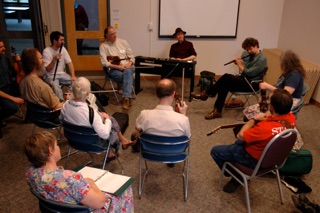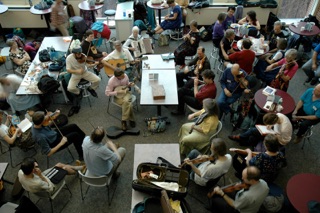
-
Ralph started calling more than 70 years ago in Nelson, NH, the Monadnock area town that has had contradancing continuously in its town hall for well over a century. He got to be quite popular as a caller both in New Hampshire and in the Boston area, and in fact during various periods in which contra and square dancing were at low points in popularity he was the only (or nearly the only) person to keep the tradition alive. It’s not at all an exaggeration to say that if it weren’t for Ralph Page we probably wouldn’t be dancing today. (By the way, the same thing can also be said of Dudley Laufman who brought the contradance scene back to life following its near death in the 1960’s.) Ralph Page became not only a caller but a scholar of contradancing. He published the Northern Junket, a far more ambitious publication than what I put out with far less sophisticated technology, monthly for many years. He wrote many excellent dances, and he researched and reconstructed many old dances. Although later in life he was known (especially by younger dancers) for his less than pleasant temperament, people who danced to him when he was younger have very fond memories of him and of his dances.
-
So, when Ralph Page died in the early 1980’s a committee was set up to keep his legacy alive; that eventually brought about the Ralph Page Dance Weekend which has occurred annually since 1988. It has turned into a weekend of outstanding dancing. From the beginning the emphasis has been on preserving the smoother style of dancing that Ralph favored (especially in his later years and especially at his Boston dances; I’m less sure about the style of dancing at his earlier rural New Hampshire dances). However, that doesn’t mean it’s a style of dancing only old people or old-fashioned dancers would enjoy. Rather, it means everyone who goes is trying to dance really well: to dance with the phrase, be ready for the next figure on time, to dance well with his/her partner, make the dances flow well, etc. So even if you enjoy a rowdy dance (which I do), it’s hard to beat dancing with a group of people all of whom are really dancing nicely together. Contra and square dancing involve teamwork, and it never shows up better than at the Ralph Page weekend.
-
These factors, plus the fact that we always make sure to hire first-class musicians and callers (the best!) lead to the comments on weekend evaluations that you read about on the RPDLW home page.
Here are some excerpts from the Seacoast Country Dance Newsletter to illustrate some of the points I hinted at on the home page.
Excellence of the Staff: Don and Cindy Roy were on staff in 2005. They’re great musicians, and I wrote the following report on them in the Feb. 2005 newsletter. Right below is the report on the 2006 Weekend in which everyone was too good to believe!
-
2005: The big dance event of the past month was clearly the Ralph Page Dance Legacy Weekend in Durham. It started off on Friday night with music by the Don Roy Trio from Maine. Don and Cindy Roy are outstanding musicians, and having Jay Young join them playing bass was very nice. The music was some of the best music I’ve ever danced to: it was exciting, solid, rhythmic, including some of my favorite Canadian jigs, reels and marches.
-
2006: As always the music was great, the calling was great, and the dancing was great; that’s just normal for the Weekend. But I think most people who attended would agree that this year was special. We don’t get Tod Whittemore to come from Arizona to call for the Weekend every year. To those of us who used to enjoy his Francestown dances so much (or for some people perhaps his Thursday night dances in Cambridge), it was a treat to see him again and to dance to his calling. We got to dance many, although not all, of the old favorite dances. Tod was obviously having a great time, which made it that much more fun for everyone. And in between it was nice to get to visit with him. When Tod wasn’t calling, Lisa Greenleaf was calling, and she’s justifiably one of the most popular callers around these days. And of course the music was outstanding too. Rod Miller’s band really can’t be beat for fine musicianship with a more modern touch (although quite capable of playing the traditional music in proper style as well); and Old New England is the best around for the more traditional style of New England dance music.
Quality, Style & Variety of the Dancing: The dancing is always excellent: smooth, on time, well-executed, but with energy and enthusiasm, great spirit; as the comments say, it just doesn’t get any better. Here’s something from the Dec. 2005 newsletter, and another from the Feb. 2002 newsletter:
-
2005: The dancing is harder to describe. We dance a combination of the old favorite dances and the more modern dances. People tend to dance in a somewhat older style, especially with the chestnuts. But most importantly people dance their best, dancing to the music, dancing with each other, keeping a friendly community atmosphere for the most part, dancing a bit more smoothly (although enthusiastically), generally paying more attention than usual. All of that makes it so everyone has more fun dancing together. Where else could you dance Money Musk for more than 20 minutes to superb music and when it’s over wish the band had kept playing another five or ten!
-
2002: Beyond that, the Ralph Page Weekend always features some of the best dancing of the year. We do a very nice selection of dances, both traditional and modern. We do some pretty easy dances which don’t require much concentration, and we do some complex dances that you really have to think about. We danced old chestnuts like Money Musk and Rory O’More, and we danced modern dances I’ve never danced before.
What’s this about Money Musk? Well, at the RPDLW we have a great time dancing it! Check out Jeremy’s and Chrissy’s comments on the other page, and the comments above. This is from the Feb. 2005 newsletter after Frank Ferrel & co. played the most amazing Money Musk; we could have danced for hours!
-
After the break on Saturday evening Mary DesRosiers called Money Musk, which has traditionally been called at that time during the dance. Everyone was really enjoying it, and the music just kept getting more and more amazing as we kept dancing. Someone said that we danced Money Musk for eighteen minutes before Mary ended it. She could have kept it going for at least another ten minutes and I doubt that anyone would have complained! We had been planning on leaving at the break but stuck around for Money Musk. After that it hardly seemed like there was any point in dancing any more, but before we could leave we heard that Chorus Jig was coming up so we danced that which was also fun.
The Workshops: Some people only come for the evening dances, but you really should come for the daytime workshops; some of them are outstanding! We have dance, calling and music workshops. Now and then we even have movies - and a crowd of dancers actually enjoys sitting and watching the movie when they could be dancing! Here’s a description of some neat workshops from the Feb. 2004 newsletter, and of the outstanding movie David Millstone created about Bob McQuillen for the Retrospective honoring him for the 2001 weekend from the Feb. 2001 newsletter. (The DVD is available from Great Meadow Music along with many excellent recordings of contradance music. Betty Ann and Pat also attend the Weekend and are great supporters of contradancing.)
-
2004: What really makes the weekend special for dancing is the interesting workshops that occur during the day. The Retrospective this year featured Chestnut Contras, and David Millstone called a good selection of the old favorites, along with some interesting commentary and quotations from Ralph Page and others. Fred Breunig did two excellent workshops. In one he called lesser known chestnuts, older dances that are fun but that aren’t called as frequently as the ones done in the Retrospective. He also did a session of singing squares from a couple old-time square-dance callers from Vermont and western Massachusetts. Those were great fun, and while similar to dances I’ve done elsewhere most were a little bit different. Either there or in another session he called a version of Spanish Cavaliero (also known as Honolulu Baby) in which the call was for a right and left and ladies’ chain, but the actual figure was a neat star-like figure in which the women turn around and go back under the men’s arch. Hopefully after the syllabus comes out I’ll be able to call the dance (if I can get a band to play the tune).
After-lunch Fiddle Jam; while others are enjoying the music finishing their lunch, we get to have a great time playing music. Photo by Patrick Stevens, used with permission.
-
And of course there were other workshops. Bob McQuillen did a music workshop called “Happy Times and Happy Tunes with Ralph Page (Hell, I was There!)”, in which he talked about the tunes he used to play in the Ralph Page Orchestra, and he told interesting and often funny stories about the people who used to play for dances.
-
2001: Saturday afternoon was devoted to celebrating Bob McQuillen and his contributions to the dance world. It started with a video which David Millstone put together, which looked at many aspects of Bob’s life, and many of the people he played with and for over the years. It was very well done, and I’d guess was the highlight of the weekend for nearly everyone there. Surprising for a bunch of people who normally would rather dance than sit around and watch other people doing things! After that was the retrospective, also organized by David Millstone. He invited many of the people Bob has played with over the years, and many of Bob’s friends and family. The music was great, there were a number of very good guest callers, and we met some of the people we’ve heard about for years but most have never met (for example, the Bear for whom the tune “The Dancing Bear” was named).
Back to the main RPDLW page.
Check out the RPDLW Photo Page!



